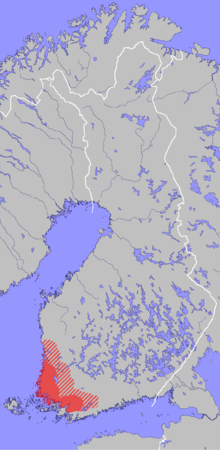Southwest Finnish dialects
The Southwest Finnish dialects (Finnish. Lounaismurteet ) are a group of dialects of the Finnish language . They belong to the West Finnish dialects.
The south-west Finnish dialects are distributed in a relatively small but, by Finnish standards, densely populated area in south-west Finland . Their distribution area covers most of the Varsinais-Suomi landscape as well as the south of Satakunta and the west of the Finnish-speaking part of Uusimaa . Towards the northeast, the Southwest Finnish dialects flow smoothly into the Häme dialects .
The Southwest Finnish dialects are divided into a number of sub-dialects. The most famous of these is the dialect of Rauma and the surrounding area, which is considered the most difficult to understand Finnish dialect.
Linguistic features
The differences between the Southwest Finnish dialects and the standard Finnish language are mainly phonological . The South-West Finnish dialects not only show all the characteristic features of the West Finnish dialects, but also show parallels to the Estonian language . The main characteristics of the Southwest Finnish dialects are:
Consonantism
- The most important isogloss between Western and Eastern Finnish dialects is the equivalent of written d . In most south-west Finnish dialects the sound has been replaced by r , in the Rauma dialect the (historically older) pronunciation has been retained as the voiced dental fricative [ ð ] (as in English the ). (Example: tehrä or tehðä instead of tehdä "to do").
- Similarly, written ts corresponds to tt in most dialects (usually with t as the weak level ), in Rauma the unvoiced dental fricative [ θ ] ( mettä or meθθä instead of metsä “forest”).
- Under certain circumstances k , t , p and s are doubled ( oikke instead of oikein "correct")
- Under certain circumstances the double consonants nn , mm , ll and rr are reduced ( kualu instead of kuollut "died").
- The final t is canceled ( snää tea instead of sinä teet “you do”), sometimes assimilation takes its place ( silmäp pääs instead of silmät päässä “eyes in the head”).
- Part are plosives after nasal (also on word boundaries) semi- voiced pronounced ( lind [ Lind ] muutaman gerra [ muːtɑmɑŋ‿g̥ɛrːɑ ] instead lintu "bird", muutaman kerran "a few times").
- The consonant groups rk and lk show deviations in the level change ( nälkä - näljä , halko - halvo instead of nälkä - nälän "the hunger - of hunger", halko - halon "the log, the log").
- In front of an original diphthong with i as the second component (even after the i has failed ) there is the weak level ( kullane instead of kultainen "golden"), which differs from the written language .
- The Southwest Finnish dialects know sounds like f and consonant clusters at the beginning of a word, which in the written language only appear in newer loan words.
Vocalism
- The contrast between stressed and unstressed syllables is particularly pronounced in the Southwest Finnish dialects. On the one hand, this leads to the characteristic staccato-like speaking rhythm of these dialects, but on the other hand it also leads to some more profound phonological processes:
- In two-syllable words with a long first syllable and all three or more syllable words, a short end vowel is omitted ( pitk , teräv instead of pitkä "long", terävä "sharp").
- In the case of words with three or more syllables, a short vowel is dropped in the second syllable if the first syllable is long ( suamlaine instead of suomalainen "Finn").
- Except in the first syllable, long vowels are shortened ( ehto instead of ehtoo "evening").
- After a short stressed syllable, a short vowel is spoken half- long ( mnää asuun Turuus [ ˈmnæː ˈɑsuˑn ˈturuˑs ] instead of minä asun Turussa “I live in Turku”).
- Under certain circumstances u , y and i as the second component of diphthongs open to o , ö and e ( laev instead of laiva "ship").
- The written diphthongs ie , uo , yö correspond to iä , ua , yä ( miäs , nuar , tyä instead of lousy “man”, nuori “young”, työ “work”).
- Except in the first syllable, there is no i in falling diphthongs ( punane instead of punainen "red").
- The final sound sequences ua , yä , ia and iä have been reduced to simple vowels ( assu instead of asua “to live”). In part, this also applies to final ea and eä ( korkki or korkkia instead of korkea "high").
Form theory
- The inessive has the ending -s instead of -ssa / -ssä ( kyläs instead of kylässä "in the village")
- In the case of the illative , the written -VVn (long vowel + n ) corresponds to the sequence VhV ( taloho instead of taloon "in the house") in the Rauma dialect . In the other Southwest Finnish dialects there are different illative endings ( talosse or talos ).
- The genitive plural has different endings ( poikkate , poikate or pojate instead of poikien "of the sons").
- The Imperfektsuffix is -si instead -i and thus corresponds to the written language Konditionalsuffix ( mnää istusi instead minä istuin "I was sitting").
literature
- Martti Rapola: Johdatus Suomen murteisiin . 2nd Edition. Helsinki: Suomalaisen Kirjallisuuden Seura, 1961.
